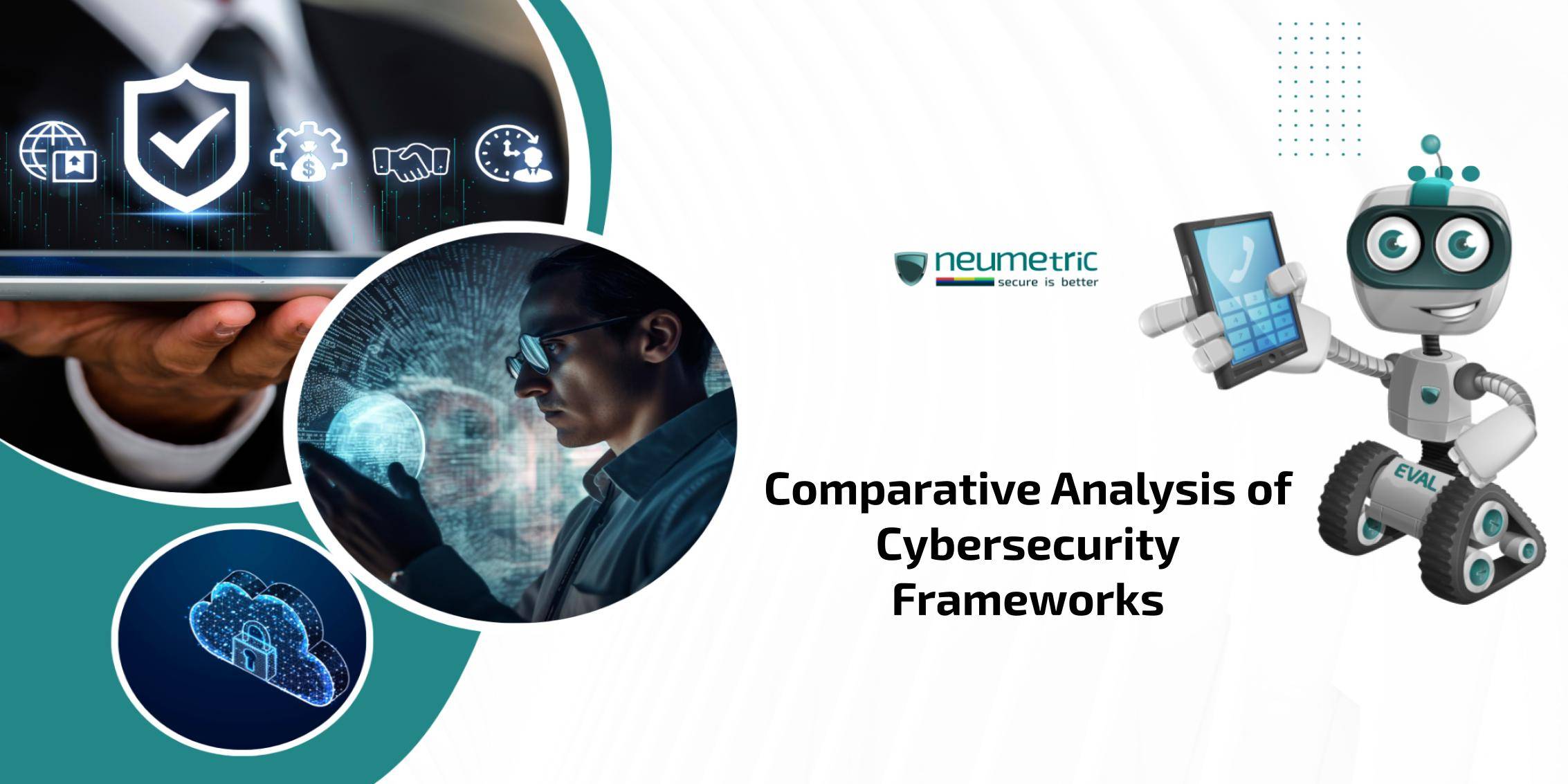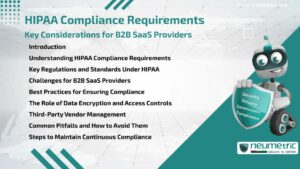Table of Contents
ToggleComparative analysis of cybersecurity frameworks
Introduction
In today’s interconnected world, where technology plays a pivotal role in our daily lives, the concept of cybersecurity has become more crucial than ever. Cybersecurity frameworks serve as structured guidelines & best practices designed to safeguard digital systems, networks & data from potential threats & vulnerabilities. These Cybersecurity Frameworks provide a systematic approach to managing & mitigating cyber risks, ensuring the Confidentiality, Integrity & Availability [CIA] of information.
The digital age has ushered in unprecedented advancements, transforming the way we communicate, work & conduct business. While these technological leaps bring countless benefits, they also expose us to new evolving cyber threats. The importance of cybersecurity lies in its ability to fortify our defences against malicious actors seeking unauthorised access, data breaches & disruption of critical systems. As our reliance on digital technologies continues to grow, so does the significance of implementing robust cybersecurity measures to protect sensitive information ensure the smooth functioning of digital ecosystems.
The purpose of conducting a comparative analysis of Cybersecurity Frameworks is to evaluate & understand the strengths, weaknesses & unique features of different approaches. By comparing various Cybersecurity Frameworks organisations can make informed decisions about which one aligns best with their specific needs, operational context & risk tolerance. This analysis aids in the selection of a Cybersecurity Frameworks that not only comply with industry standards but also addresses the specific challenges & requirements of an organisation. Additionally, these Cybersecurity Frameworks help in identifying gaps or overlaps in existing frameworks, enabling the development of a comprehensive & effective cybersecurity strategy.
Comparative analysis of cybersecurity frameworks
International Organisation for Standardisation [ISO] 27001:
Scope: ISO 27001 is a global standard that provides a framework for establishing, implementing, maintaining & continually improving an Information Security Management System [ISMS].
Focus: Primarily focuses on the establishment & maintenance of an ISMS, covering processes & controls related to information security.
Applicability: Not industry-specific & can be applied to any organisation.
Certification: Organisations can achieve ISO 27001 certification by undergoing a third-party audit by an external Certifying Body.
Service Organization Control [SOC] 2:
Scope: Developed by the American Institute of CPAs [AICPA], SOC 2 is designed for service providers storing customer data in the cloud & focuses on the Security, Availability, Processing Integrity, Confidentiality & Privacy of customer data.
Focus: Targets technology & cloud computing organisations, emphasising the security & privacy of data.
Applicability: Relevant to service providers hosting customer data in the cloud.
Certification: SOC 2 compliance is achieved through a third-party audit performed by a Certified Public Accountant [CPA].
General Data Protection Regulation [GDPR]:
Scope: The European Union regulation that governs the processing & protection of personal data.
Focus: Emphasises the rights of individuals regarding their personal data & imposes obligations on organisations that process or control this data.
Applicability: Applies to organisations processing personal data of EU residents, regardless of the organisation’s location.
Certification: GDPR compliance is self-assessed & organisations are responsible for ensuring their own compliance.
National Institute of Standards & Technology [NIST] Framework:
Scope: Developed by the U.S. National Institute of Standards & Technology [NIST], it’s one of the Cybersecurity Frameworks for managing & improving cybersecurity risk.
Focus: Provides a flexible & voluntary framework applicable to various industries, emphasising risk management & cybersecurity practices.
Applicability: Widely used in the U.S. & beyond, especially in critical infrastructure sectors.
Certification: NIST compliance is not a certification but is often used as a guideline for organisations.
Health Insurance Portability & Accountability Act [HIPAA]
Scope: U.S. legislation governing the security & privacy of health data.
Focus: Specifically addresses the healthcare industry & sets standards for the protection of electronic Protected Health Information [ePHI].
Applicability: Applies to healthcare providers, health plans & healthcare clearinghouses handling ePHI.
Certification: HIPAA compliance is mandatory for covered entities & is enforced through audits conducted by the U.S. Department of Health & Human Services
Let’s dive into the fascinating world of cybersecurity frameworks, where we’ll be taking a closer look at the NIST Cybersecurity Framework. Think of it as the superhero suit for organisations looking to shield themselves from the ever-evolving threats lurking in the digital shadows.
NIST Cybersecurity Framework
NIST or the National Institute of Standards & Technology, provides a Cybersecurity Framework – a robust set of guidelines & best practices designed to help organisations enhance their cybersecurity posture. This isn’t just a tool; it’s a philosophy, a shield against the digital storm.
Think of the NIST framework as having a superhero utility belt with five key functions: Identify, Protect, Detect, Respond, Recover. Each function plays a crucial role in the grand scheme of cybersecurity resilience. Identification is like knowing your enemy, Protection is the armour, Detection is the vigilant watchtower, Response is the rapid counterattack & Recovery is the comeback story.
The beauty of NIST lies in its adaptability. It’s not a one-size-fits-all; rather, it’s like a customizable cyber-armor. Organisations can tailor the framework to their specific needs, aligning it with their unique risks, goals & resources.
Imagine a world where everyone spoke the same cybersecurity language. NIST aims for just that. By providing a common vocabulary, it facilitates communication across teams, from the IT wizards to the C-suite. It’s like having a secret handshake that ensures everyone’s on the same page, defending the digital fortress together.
NIST doesn’t just throw guidelines at you; it holds your hand through the risk management journey. It encourages organisations to assess, analyse & prioritise risks. It’s not just about building a wall; it’s about knowing which walls need reinforcing the most.
In the ever-changing landscape of cyber threats, stagnation is a vulnerability. NIST emphasises continuous improvement, urging organisations to regularly reassess & fine-tune their cybersecurity strategies. It’s not just about building a castle; it’s about evolving it into an impenetrable fortress.
The NIST Cybersecurity Framework isn’t just an American superhero; it’s gone global. Many organisations worldwide have adopted or adapted its principles, recognising the need for a standardised approach to cybersecurity. It’s like a global alliance against the digital forces of evil.
While NIST is a superhero in its own right, it doesn’t work in isolation. Often organisations combine it with other frameworks like ISO 27001 or CIS Controls to create a cybersecurity dream team. It’s about finding the right combination of skills & tools to face the unique challenges each organisation encounters.
In a nutshell, the NIST Cybersecurity Framework isn’t just a document; it’s a guide, a mentor & a steadfast companion in the ever-expanding universe of digital threats. As organisations navigate the complex maze of cybersecurity, having NIST by their side is like having a seasoned guide leading them through the digital wilderness.
Comparative analysis
Framework objectives & scope
Identifying commonalities:
In the cyber realm, finding common ground is like striking gold. When we talk about cybersecurity frameworks, it’s not just a bunch of jargon or acronyms. Each framework, be it NIST’s Cybersecurity Framework, ISO 27001 or CIS Critical Security Controls, has a shared goal: protecting the digital universe from the bad actors.
At their core, these frameworks aim to fortify defences, identify vulnerabilities & ensure that sensitive data stays as secure as your grandma’s secret cookie recipe. So, whether you’re sipping coffee at NIST or tea with ISO, the common mission is to shield cyberspace from the wolves in hacker’s clothing.
Highlighting differences:
Now, let’s talk about the spice of life – differences. While they say opposites attract, in the world of cybersecurity frameworks, distinctions add layers of complexity. NIST might prefer the “Identify, Protect, Detect, Respond, Recover” method, while ISO 27001 opts for the more structured Plan-Do-Check-Act [PDCA] method.
Some frameworks might be more tailored for certain industries or company sizes. The granularity of controls, the approach to risk management & even the language used can be as diverse as a multicultural potluck.
In essence, these differences aren’t about one-upping each other. They’re more like different methods for different organisations. Understanding these distinctions is key for organisations to pick a cybersecurity partner that resonates with their unique business model.
Conclusion
As we wrap up our journey through the intricate landscape of cybersecurity frameworks, it’s evident that the digital realm is a battleground where security is paramount. In this age of relentless cyber threats organisations need a robust cybersecurity strategy more than ever. Our comparative analysis has underscored the importance of selecting a framework that aligns seamlessly with the specific needs & structure of an organisation. One size certainly doesn’t fit all in the cybersecurity realm.
First & foremost organisations should conduct a thorough risk assessment to identify their unique vulnerabilities. This step is crucial in determining the most suitable framework tailored to their specific threats & regulatory environment. It’s like having a customised suit – it fits better & offers better protection.
Once the right framework is in place, continuous monitoring & updates are the keys to maintaining an effective cybersecurity posture. Threat landscapes evolve so should your defence mechanisms. Regular audits & assessments will help organisations stay ahead of the curve & ensure their security protocols are up to par.
Moreover, fostering a culture of cybersecurity awareness among employees is equally critical. Humans often serve as the weakest link & a well-informed workforce can act as an additional layer of defence. Training programs, simulated phishing exercises & clear communication of security policies can significantly enhance an organisation’s overall cyber resilience.
Frameworks should not be seen as rigid structures but rather as living organisms that can adapt to the ever-changing threat landscape. Integration with emerging technologies like Artificial Intelligence [AI] and Machine Learning [ML] will become increasingly vital. These technologies can provide proactive threat detection & response capabilities, adding a layer of intelligence to our defence mechanisms.
Organisations must be agile & proactive in their approach. By selecting the right framework, staying vigilant embracing the evolving nature of cybersecurity, organisations can fortify their digital fortresses against the relentless tide of cyber threats. Remember, it’s not just about building walls; it’s about building smart, adaptive resilient systems that can withstand the tests of time & technology. Stay secure out there!
FAQ
Why is it so crucial for organisations to conduct a risk assessment before choosing a cybersecurity framework?
Conducting a risk assessment is like putting on a tailored suit – it ensures a perfect fit. Just as every person has a unique physique, every organisation has distinct vulnerabilities. A risk assessment helps identify those weak spots, allowing organisations to pick a cybersecurity framework that suits their specific threats & regulatory environment. It’s not about one-size-fits-all; it’s about finding the right match for your cybersecurity wardrobe.
How can organisations foster a culture of cybersecurity awareness among their employees?
Think of cybersecurity awareness as the secret sauce in your security recipe. First off, it’s about communication – clear, concise & constant. Employees need to know the do’s & don’ts. Throw in some training programs, spice it up with simulated phishing exercises voila! You’ve got a workforce that’s not just aware but actively participating in the defence game. It’s like having your team as an extra layer of security – because in the end, we’re all in this cyber battle together.
What’s the deal with integrating artificial intelligence machine learning into cybersecurity frameworks?
Imagine your cybersecurity framework as a superhero – now imagine it with superintelligence. That’s the deal with AI & machine learning. These technologies aren’t just buzzwords; they’re the sidekicks that make your defence mechanisms smarter & more proactive. They add a touch of foresight, helping you detect & tackle threats before they even knock on your digital door. It’s not just about building walls anymore; it’s about having an army of algorithms standing guard, ready to face the challenges of the ever-evolving cyber world.





